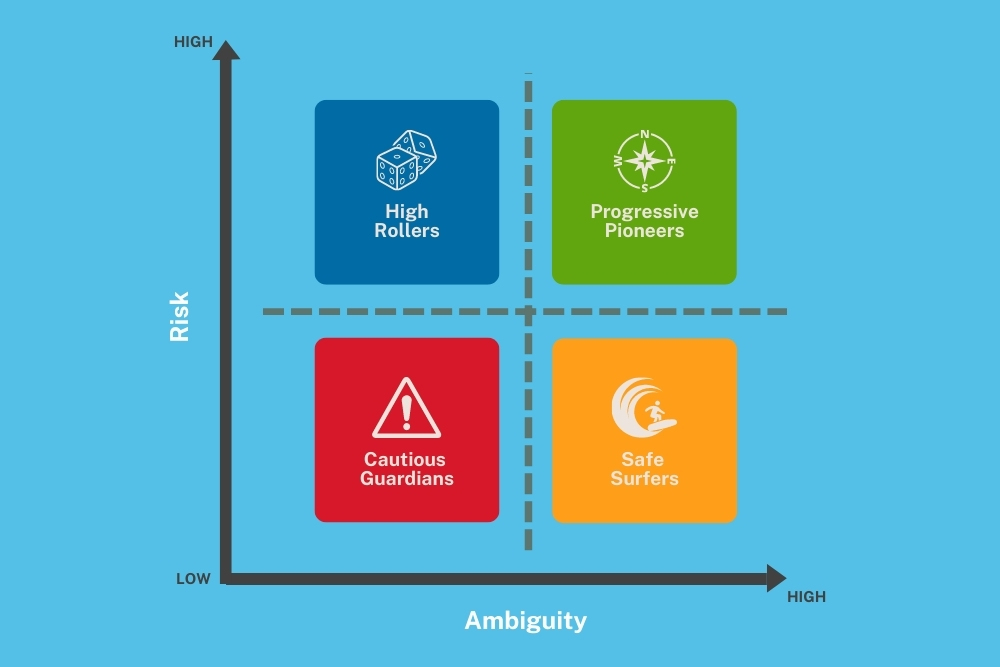When you know who you are, it’s easy to know what to do.
A successful HR organization knows who it is.
This is different than knowing what it does.
**Register for Amy Haworth’s upcoming webinar, Embracing Change: Managing Employee Expectations in the New World of Work, on Aug. 18th. You don’t want to miss this timely event!**
While working as the Chief of Staff for HR in a mid-size global technology firm, a core component of my role was to help define roadmap and priorities for the coming year.
There was always more to do than there were resources. I’m sure you can relate.
When it came to prioritizing what to work on and how to scope it, it became clear that the first step was recalibrating who we were as an organization.
There are several frameworks you might be familiar with to enable this activity, but the one I find most useful is a 2×2 Risk/Ambiguity model.
Deciding how to scope an effort came down to deciding who we were. Because once we explicitly stated how much risk we were willing to take on and how much ambiguity we would operate with, the type of initiative we needed to prioritize and its scope emerged.
Which of the four types below most closely represents your HR organization? It’s important to note that none of these is better than the other.
Cautious Guardians (Low Ambiguity / Low Risk):
Cautious Guardians rely on process and policy to offer certainty and minimize risk. When an HR team identifies as a Cautious Guardian it typically has a low tolerance for legal action, a high volume and use of documented policies, and (potentially) exists within organizations that are part of heavily regulated industries.
Cautious Guardians are not:
- Early adopters
- Likely to set the precedent for progressive talent programs and practices
Safe Surfers (High Ambiguity / Low Risk):
Safe Surfers are expert at riding small to medium ‘waves’. They don’t show up to work expecting clarity. Instead they look to the horizon, find the wave, and ride it. When an HR team identifies as a Safe Surfer, it may find a balance in designing for the future and keeping the trains running. When it designs it alters an existing idea/process/tool vs. inventing with a blank canvas. Safe surfers make a constant trade-off in day-to-day activities between reactive tasks to the tasks that form the foundation and path to the future.
Safe Surfers are not:
- Bogged down when there is uncertainty
- Transformers (but they don’t mind introducing incremental change)
High Rollers (Low Ambiguity / High Risk):
High Rollers make big bets when opportunities are clearly defined. For example, high rollers find it easy to say ‘yes’ to an enterprise human capital system. The investment and visibility is high, but it’s completely clear what the intended outcome will be. These types of HR teams make progress by adding structure: clear key performance indicators (KPIs), data-driven outcomes, processes to course correct, and project management discipline.
High Rollers are not:
- Wedded to past investments – sunk cost bias is not an issue
- Hiding in the shadows – their employees are aware of changes that originate from HR
Progressive Pioneers (High Ambiguity / High Risk):
If HR answers that it is a pioneer in the talent space vs. a follower, it will push the envelope for more innovative programs and practices. These HR teams are establishing the future for talent. They look 5-10 years into the future and work backwards. There is no precedent and no system that exists for what they need. They are willing to fail forward, and ask for different types of support and investment from the executive leadership and Board. They are likely part of fast-moving companies that invest heavily in programs to keep talent engaged.
These types of HR teams are not:
- Interested in making everyone happy
- Doing what everyone else is doing (or has done)
Call to Action
When setting priorities during annual planning, it’s important to define who the HR organization is in the coming year. Failing to explicitly define which quadrant best qualifies the HR team costs HR precious time allowing individual preferences or the allure of new tools and technology to drive its actions. In addition to asking “who are we”, HR teams need to also ask “who do we need to be” (for employees? for the business to succeed?). Discovering if there’s a different answer to the second question surfaces future tension and decisions.
Amy Haworth is Executive Coach and Guide at Chief, a private membership network focused on connecting and supporting women in executive leadership.


